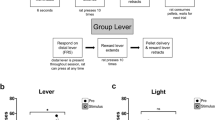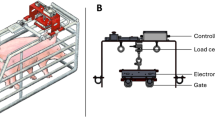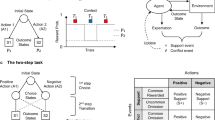Abstract
SINCE the work of Skinner and his associates1, free responding techniques, in which an organism can respond repetitively without altering the stimulus situation, have commonly been used in studying discrimination learning in the pigeon. Guttman and Kalish2 developed a procedure for obtaining reliable measures of response strength at different “values” along a “stimulus dimension” (for example, wavelength of a patch of light); from these, “stimulus control functions” could be plotted. This procedure has been used by Hanson3 to obtain post-discrimination stimulus control functions, and later workers have used a wide variety of experimental designs and stimulus dimensions4. In a free responding situation however, as Jenkins has pointed out5, the assessment of stimulus control may be subject to error from confounding effects—for example, a reinforcement within a stimulus presentation may in itself lead to an increased rate of responding on that presentation. He suggests that these effects can be overcome most easily by the use of a discrete trial training procedure, in which the organism's response terminates the trial. But the free responding Guttman and Kalish procedure for measuring stimulus control functions then becomes inappropriate.
This is a preview of subscription content, access via your institution
Access options
Subscribe to this journal
Receive 51 print issues and online access
$199.00 per year
only $3.90 per issue
Buy this article
- Purchase on SpringerLink
- Instant access to full article PDF
Prices may be subject to local taxes which are calculated during checkout
Similar content being viewed by others
References
Ferster, C. B., and Skinner, B. F., Schedules of Reinforcement (Appleton, NY, 1957).
Guttman, N., and Kalish, H. I., J. Exp. Psychol., 51, 79 (1956).
Hanson, H. M., J. Exp. Psychol., 58, 321 (1959).
Honig, W. K., Animal Discrimination Learning (edit. by Gilbert, R. M., and Sutherland, N. S.) (Academic Press, London, 1969); Terrace, H. S., Operant Behaviour: Areas of Research and Application (edit. by Honig, W. K.) (Appleton, NY, 1966).
Jenkins, H. M., Psychol. Bull., 64, 365 (1965).
David, H. A., The Method of Paired Comparisons (Griffin, London, 1963).
Torgerson, W. S., Theory and Methods of Scaling (Wiley, NY, 1958).
Fellows, B. J., Psychol. Bull., 67, 87 (1967).
Bloomfield, T. M., Nature, 217, 5132, 929 (1968).
Terrace, H. S., Science, 154, 1677 (1966).
Thomas, D. R., and Williams, J. L., J. Exp. Anal. Behav., 6, 171 (1963).
Weisman, R. G., J. Exp. Anal. Behav., 12, 443 (1969).
Honig, W. K., J. Exp. Psychol., 64, 239 (1962).
Author information
Authors and Affiliations
Rights and permissions
About this article
Cite this article
ROBSON, C. Paired Comparison Technique for measuring Stimulus Control Functions in the Pigeon after Training with Discrete Trials. Nature 228, 1112–1113 (1970). https://doi.org/10.1038/2281112a0
Received:
Issue date:
DOI: https://doi.org/10.1038/2281112a0



